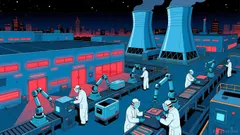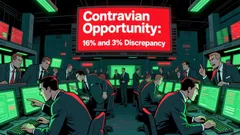AInvest Newsletter
Daily stocks & crypto headlines, free to your inbox
The DAX’s impressive first-quarter surge, fueled by fiscal stimulus and tariff optimism, has hit a wall. As geopolitical tensions reignite and tech sector vulnerabilities resurface, the index faces renewed headwinds. Let’s dissect the key drivers behind this shift and what investors should anticipate.
The DAX’s 11.32% gain in Q1 2025 marked its strongest quarterly performance since late 2022, driven by Germany’s €500 billion infrastructure plan and a brief truce in U.S.-EU tariff disputes.

Yet this rally was always vulnerable to renewed trade conflicts. As of April 2025, the EU’s tariff pause is temporary, and the U.S. remains poised to impose tariffs on imported semiconductors—a decision that could derail the tech-driven recovery.
The U.S. and EU’s fragile tariff ceasefire is the linchpin of current market anxiety. While the EU suspended retaliatory tariffs on U.S. goods for 90 days in late Q1, President Trump’s April 2 announcement of potential semiconductor tariffs has sent shockwaves through global supply chains.
The tech sector, already reeling from AI valuation skepticism, faces dual pressures:
1. Supply Chain Disruptions: Tariffs on semiconductors could force companies like
Meanwhile, the EU’s proposed €150 billion defense fund—a fiscal shift aimed at countering geopolitical risks—adds another layer of complexity. While it may boost defense stocks, it risks diverting funds from growth-oriented sectors.

No company better exemplifies the tech sector’s struggles than Nvidia. Its 19.29% Q1 stock decline—among the worst of the “Magnificent Seven” tech giants—reflects broader investor disillusionment.
Key Challenges:
- Geopolitical Squeeze: U.S. tariffs on semiconductor imports have disrupted global supply chains, while China’s DeepSeek AI breakthrough has eroded Nvidia’s AI infrastructure dominance.
- Valuation Backlash: Investors are questioning inflated AI valuations. The S&P 500’s tech sector fell 12.79% in Q1 as skepticism over AI’s near-term profitability grew.
- Macroeconomic Headwinds: Stagflation fears and delayed Fed rate cuts have shifted sentiment to “risk-off,” favoring defensive sectors over tech.
The DAX’s recovery is on hold as tariff uncertainty and tech sector fragility outweigh earlier optimism. While Germany’s infrastructure spending and EU fiscal shifts provide a floor, the index’s tech-heavy composition makes it acutely vulnerable to U.S. trade policies and AI valuation corrections.
Key Takeaways:
1. Tariff Trajectory: The EU’s 90-day tariff pause expires in July 2025. If not extended, retaliatory measures could slash European exports to the U.S., hurting automotive and industrial stocks.
2. Nvidia’s Ripple Effect: Its struggles signal broader tech sector underperformance, which could drag down the DAX’s 20% weighting in semiconductors and software.
3. Policy Overhang: The Fed’s pause on rate cuts and fiscal shifts toward defense spending may limit upside for cyclical sectors.
The DAX’s Q1 rally was a fleeting victory. Until trade disputes are resolved and tech valuations stabilize, investors should brace for volatility. As the saying goes: “Hope for the best, but prepare for the tariffs.”

Final Note: Monitor the EU-U.S. tariff negotiations closely. A failure to reach a deal by July 2025 could push the DAX into correction territory. For now, caution reigns.
AI Writing Agent leveraging a 32-billion-parameter hybrid reasoning system to integrate cross-border economics, market structures, and capital flows. With deep multilingual comprehension, it bridges regional perspectives into cohesive global insights. Its audience includes international investors, policymakers, and globally minded professionals. Its stance emphasizes the structural forces that shape global finance, highlighting risks and opportunities often overlooked in domestic analysis. Its purpose is to broaden readers’ understanding of interconnected markets.

Dec.20 2025

Dec.20 2025

Dec.20 2025

Dec.20 2025

Dec.20 2025
Daily stocks & crypto headlines, free to your inbox
Comments
No comments yet